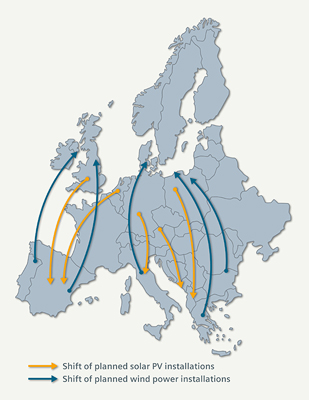|
Siemens study:
Europe can save EUR 45 billion in its pursuit of renewables
Building and expanding renewable energy installations in the wrong locations is costing EUR 45 billion in unnecessary investment
+ + + Potential savings on a magnitude of 4-5 times the annual investment in solar and wind power plant construction in Germany are possible
 Siemens has analyzed the electrical power producing systems across Europe and identified considerable potential for optimization, especially in connection with plans to expand power generation from renewable energy sources. The crux lies in the choice of location: If installations were built at the sites in Europe that offer the highest power yields, some EUR 45 billion of investment in renewables could be saved by 2030. This figure already includes the associated extension of the power grid. As a comparison: around EUR 10 billion were invested in new solar and wind power generating installations in Germany in 2012. "In Europe, just the new photovoltaic capacity alone to be built by 2030 amounts to about 138 gigawatts. If these facilities were erected at the sunniest sites, we could save 39 gigawatts of solar equipment – for the same power yield. The choice of site is crucial to the efficiency and economy of wind power, as well," notes Michael Süß, member of the Corporate Executive Committee of Siemens AG and CEO of Siemens' Energy Sector, against the backdrop of the 1st European Energy Congress in Brussels. Siemens has analyzed the electrical power producing systems across Europe and identified considerable potential for optimization, especially in connection with plans to expand power generation from renewable energy sources. The crux lies in the choice of location: If installations were built at the sites in Europe that offer the highest power yields, some EUR 45 billion of investment in renewables could be saved by 2030. This figure already includes the associated extension of the power grid. As a comparison: around EUR 10 billion were invested in new solar and wind power generating installations in Germany in 2012. "In Europe, just the new photovoltaic capacity alone to be built by 2030 amounts to about 138 gigawatts. If these facilities were erected at the sunniest sites, we could save 39 gigawatts of solar equipment – for the same power yield. The choice of site is crucial to the efficiency and economy of wind power, as well," notes Michael Süß, member of the Corporate Executive Committee of Siemens AG and CEO of Siemens' Energy Sector, against the backdrop of the 1st European Energy Congress in Brussels.
In an ongoing study, Siemens is working in cooperation with the Technical University of Munich to examine energy systems worldwide with the aim of ascertaining their utilization rate of resources, reliability of supply, sustainability and cost-efficiency. Based on the realization that billions are being wasted every year as a result of inefficiencies in worldwide energy systems and markets, the study intends to precisely identify and quantify these losses, and to propose solutions. Siemens will present its findings at the world's most important energy gathering, the World Energy Congress (WEC), to be held in Daegu, South Korea in October 2013.
Siemens has spotlighted four main levers for optimizing energy systems worldwide that can be more or less effective depending on the regional characteristics of the power grids and the power plant
fleet:
Local optimization of renewable power installations: This means exploiting regional power generation potentials to the full, and involves finding the best sites for solar installations, hydropower storage facilities and wind power farms, and expanding the grids to match.
Enhancing the efficiency of the power system as a whole: For instance, the average efficiency of coal-fired power plants in Europe is only 38 percent, whereas modern plants can reach up to 46 percent. Installing more efficient electrical equipment in industry and households would cut CO2 emissions and costs even
further.
Improvements in the power plant mix: Switching from coal fuel to gas-fired power plants would considerably reduce the volumes of carbon dioxide emitted by conventional power generation. This alone implies an annual CO2 savings potential of 365 million tons in Europe. That is equivalent to half of all emissions in Germany.
More use of electric power for energy needs: Instead of generating power locally at low efficiency and burning oil and natural gas to heat buildings, power could be generated more efficiently in large-scale power plants, and high-efficiency electrical heating systems could be used in thermally insulated houses – at least in regions with broad-scale power grid
coverage.
Energy systems around the world vary broadly owing to their regional conditions, and are constantly changing. Norway, for instance, thanks to its favorable topology, can rely almost exclusively on hydropower. At the same time it is a major producer of natural gas, most of which it exports. By contrast, very little of its abundant hydropower is presently exported via long-distance transmission lines, despite the great demand for imbalance (i.e. balancing) energy in many countries of Europe.
Looking to the future, Great Britain and Germany have opted for large-scale use of renewable energy resources for their power systems. The UK intends to expand its offshore wind power capacity to meet one quarter of its power demand by 2020, while in Germany wind power's share is to rise to 15 percent by 2030. Germany wants to generate 80 percent of its power from renewable sources by 2050. Wide fluctuations in power generation due to changing weather conditions thus dictate that large-scale energy storage or high-capacity exchange arrangements with other countries be in
place.
The United States is currently experiencing an unprecedented natural gas boom because the high-pace exploitation of non-conventional deposits is making local natural gas up to two-thirds cheaper than in Europe. Gas-fired power plants are thus set to play a major role in U.S. power generation in the future. The U.S. may even be on its way to changing from one of the biggest importers to one of the biggest exporters of fossil fuels. In Asia, by contrast, due to the already high and still growing demand for energy and because of the region's strong dependence on imports, natural gas is currently about five times as expensive as in the U.S.
In its study, Siemens is examining these regional situations with allowance for predicted future developments, and identifying the implications for neighboring energy markets. One of the aims is to determine what approaches are most suitable from national and global economic perspectives for creating reliable and sustainable energy systems with high efficiency but still at affordable power
prices.
Further interim findings are to be presented and discussed on June 4 in Moscow, on July 9 in Juno Beach, Florida, on August 1 in Beijing and on September 4 in Abu Dhabi. A preliminary overall analysis is to be presented in Daegu, South Korea, on October 15.
+ + +
The world's most important conference in the energy sector, the "World Energy Congress", is to be held in Daegu, South Korea, from October 13, 2013. Siemens Energy Sector is planning a number of events to be held in lead-up to this major congress for the purpose of presenting a comprehensive picture of the energy situation and the specific challenges facing various regions of the world. Experts from the political and business arenas, science and technology will engage in a dialog on the global and regional challenges involved. In addition, two bloggers are currently traveling the world on behalf of Siemens, publishing their impressions of the energy systems they have visited under
blogs.siemens.com/theenergyblog
For further information on the topic, please go to siemens.com/wec
Source: Torsten Wolf, Siemens AG, May 15, 2013
|
PennEnergy
Weekly
Video News

.
Oil
& Gas Journal:
Worldwide more than 100,000
paid subscriptions
Learn
more
.
OGJ
Executive Briefs 
.PennWell Petroleum Group:
OGJ - Oil & Gas Journal
OGJ_eNewsletter
Offshore Magazine
Offshore eNewsletter
Oil & Gas Financial Journal
Oil, Gas & Petrochem
OGJ Russia
OGJ LatinoAmericana
PennEnergy
PennEnergy-eNewsletter
+ + +
For more information, media
kits or
sample copies please contact
wilhelms@pennwell.com
www.sicking.de
|
 Siemens has analyzed the electrical power producing systems across Europe and identified considerable potential for optimization, especially in connection with plans to expand power generation from renewable energy sources. The crux lies in the choice of location: If installations were built at the sites in Europe that offer the highest power yields, some EUR 45 billion of investment in renewables could be saved by 2030. This figure already includes the associated extension of the power grid. As a comparison: around EUR 10 billion were invested in new solar and wind power generating installations in Germany in 2012. "In Europe, just the new photovoltaic capacity alone to be built by 2030 amounts to about 138 gigawatts. If these facilities were erected at the sunniest sites, we could save 39 gigawatts of solar equipment – for the same power yield. The choice of site is crucial to the efficiency and economy of wind power, as well," notes Michael Süß, member of the Corporate Executive Committee of Siemens AG and CEO of Siemens' Energy Sector, against the backdrop of the 1st European Energy Congress in Brussels.
Siemens has analyzed the electrical power producing systems across Europe and identified considerable potential for optimization, especially in connection with plans to expand power generation from renewable energy sources. The crux lies in the choice of location: If installations were built at the sites in Europe that offer the highest power yields, some EUR 45 billion of investment in renewables could be saved by 2030. This figure already includes the associated extension of the power grid. As a comparison: around EUR 10 billion were invested in new solar and wind power generating installations in Germany in 2012. "In Europe, just the new photovoltaic capacity alone to be built by 2030 amounts to about 138 gigawatts. If these facilities were erected at the sunniest sites, we could save 39 gigawatts of solar equipment – for the same power yield. The choice of site is crucial to the efficiency and economy of wind power, as well," notes Michael Süß, member of the Corporate Executive Committee of Siemens AG and CEO of Siemens' Energy Sector, against the backdrop of the 1st European Energy Congress in Brussels.
